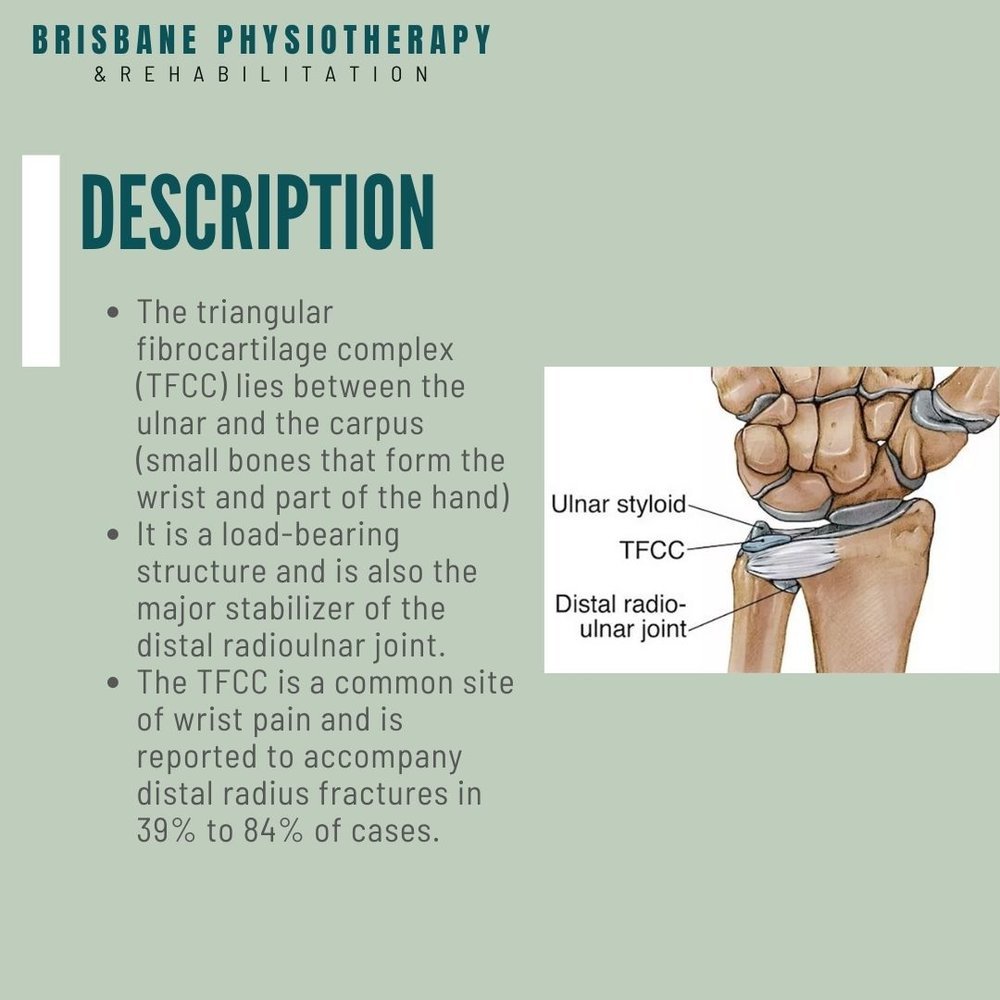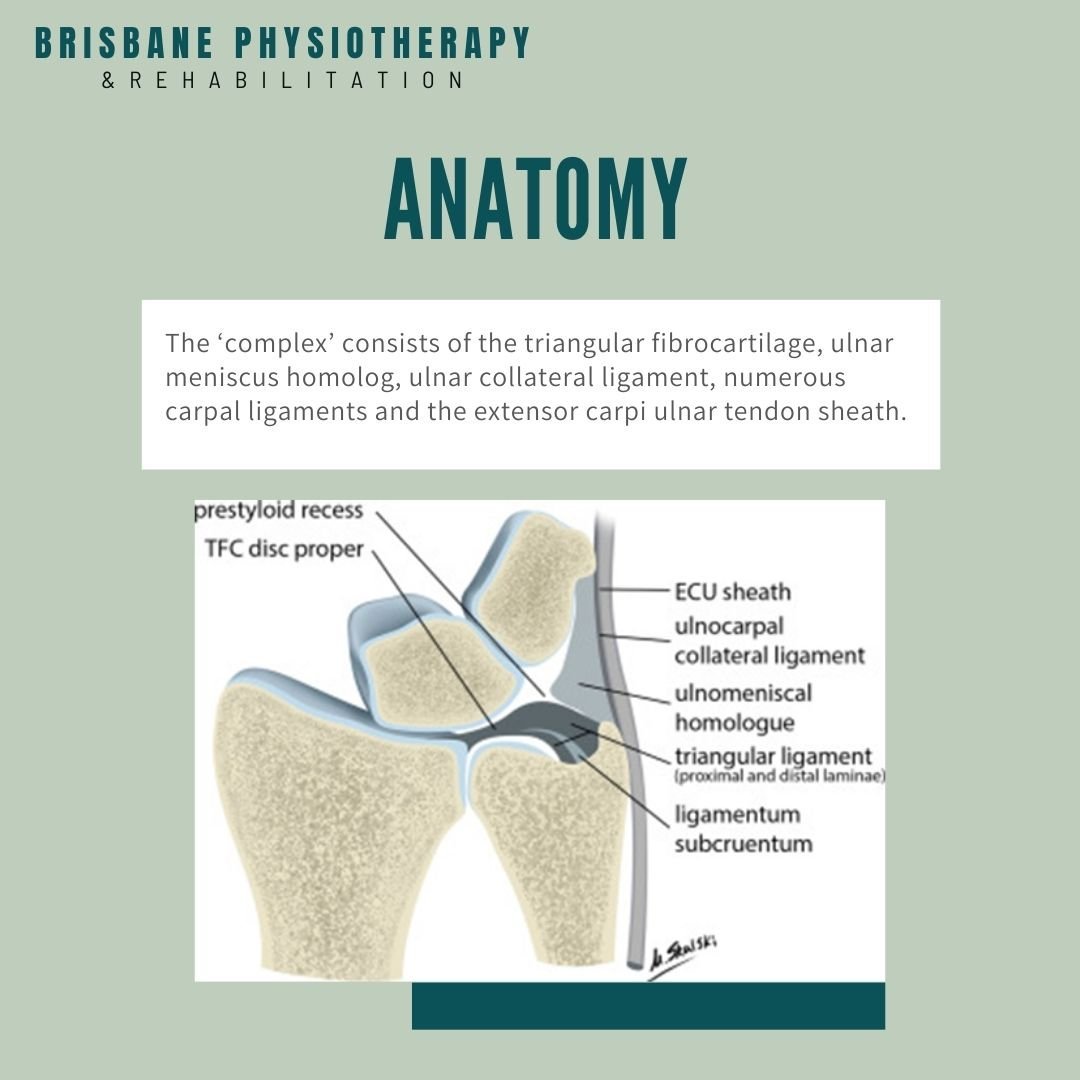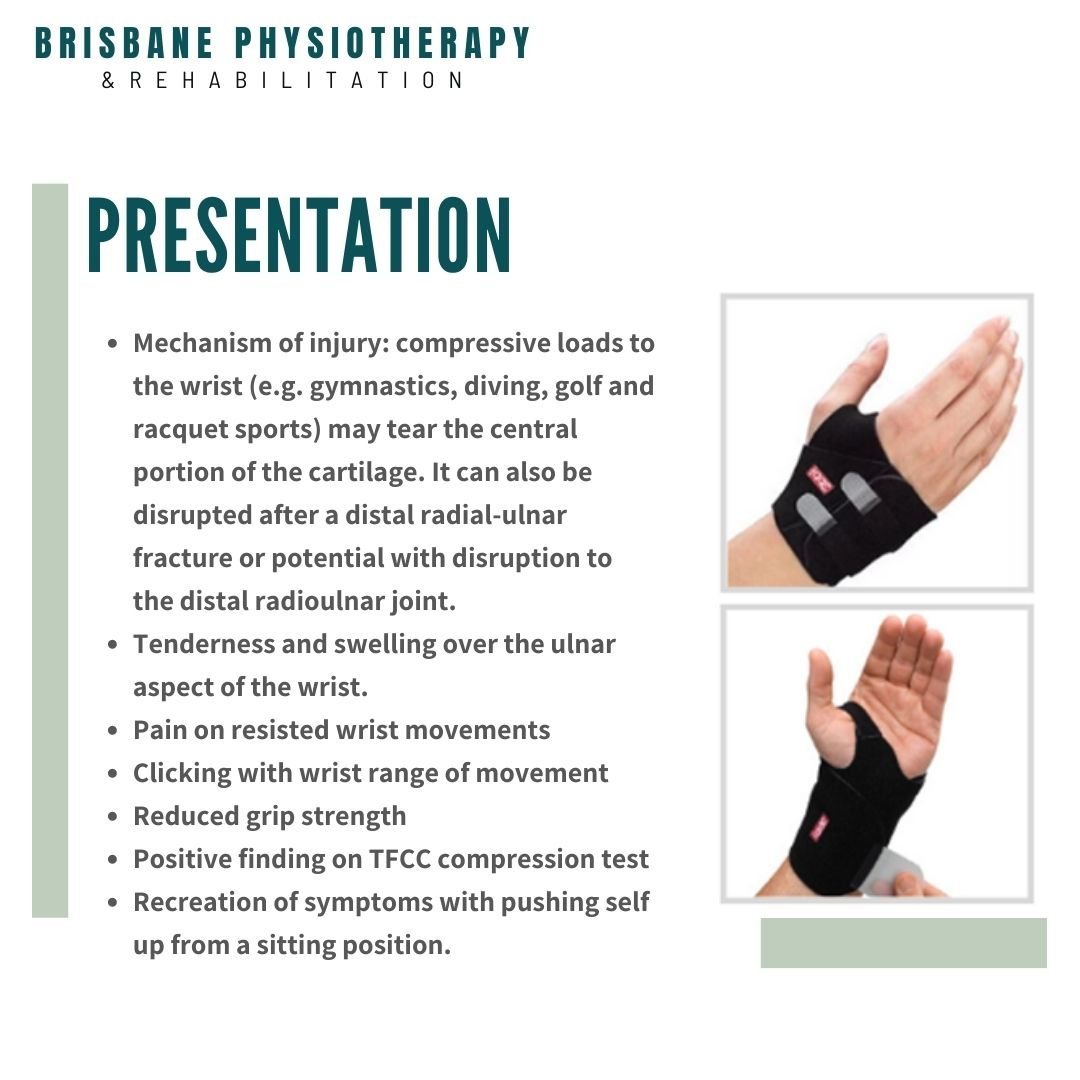TFCC Tears (Triangular Fibrocartilage Complex)
Introduction:
The triangular fibrocartilage complex (TFCC) is a critical structure in the wrist that provides stability and cushioning to the joint. The TFCC is a load-bearing structure and is also the major stabiliser of the distal radioulnar joint. The TFCC is a common site of wrist pain and is reported to accompany distal radius fractures in 39% to 84% of cases. A TFCC tear occurs when there is damage to the cartilage, ligaments, or tendons within this complex, often resulting from trauma, repetitive strain, or degenerative changes. Individuals with TFCC tears may experience pain, swelling, and limited wrist mobility, impacting daily activities and athletic performance.
Anatomy
The TFCC complex consists of the triangular fibrocartilage, ulnar meniscus homolog, ulnar collateral ligament, numerous carpal ligaments and the extensor carpi ulnar tendon sheath.
What is a TFCC tear?
Presentation
Mechanism of injury: compressive loads to the wrist (e.g. gymnastics, diving, golf and racquet sports) may tear the central portion of the cartilage. It can also be disrupted after a distal radial-ulnar fracture or potential with disruption to the distal radioulnar joint.
- Tenderness and swelling over the ulnar aspect of the wrist.
- Pain on resisted wrist movements
- Clicking with wrist range of movement
- Reduced grip strength
- Positive finding on TFCC compression test
- Recreation of symptoms with pushing self up from a sitting position.
Understanding TFCC Tears:
The TFCC is located on the ulnar side of the wrist, between the ulnar and the carpus (small bones that form the wrist and part of the hand) and consists of cartilage, ligaments, and tendons that stabilise the joint and support its movements. TFCC tears can occur due to various reasons, including:
Trauma: Falls onto an outstretched hand, direct impact to the wrist, or sudden twisting motions can cause tears in the TFCC.
Repetitive Strain: Overuse of the wrist, such as repetitive gripping or twisting motions common in sports or certain occupations, can lead to gradual wear and tear of the TFCC.
Degenerative Changes: Aging-related changes or conditions like arthritis can weaken the TFCC over time, making it more susceptible to tears.
Symptoms of TFCC tears may include:
Pain: Sharp or dull pain on the ulnar side of the wrist, exacerbated by gripping, twisting, or weight-bearing activities.
Swelling: Inflammation and swelling around the wrist joint, often accompanied by warmth and tenderness to touch.
Clicking or Catching Sensation: Sensation of clicking, popping, or catching in the wrist during movement, indicating possible instability or mechanical issues.
Managing a TFCC Tear
Physiotherapy Interventions:
Physiotherapy plays a crucial role in the management of TFCC tears by reducing pain, restoring mobility, and strengthening the wrist and surrounding muscles. Here are some effective physiotherapy interventions:
Rest and Immobilization: Initially, rest and immobilisation of the wrist may be necessary to allow the TFCC tear to heal. Protective splinting or bracing for 3 to 6 weeks can provide support and stability during the early stages of recovery.
Manual Therapy: Hands-on techniques such as soft tissue mobilisation, joint mobilisation, and myofascial release can help alleviate pain, improve joint mobility, and restore normal tissue function.
Therapeutic Exercises: Targeted exercises to strengthen the muscles around the wrist, forearm, and hand, enhancing stability and reducing strain on the TFCC. These may include wrist flexion and extension exercises, forearm pronation and supination, and grip strengthening exercises.
Modalities: Therapeutic modalities such as ice therapy, heat therapy, ultrasound, and electrical stimulation may be used to reduce pain and inflammation in the affected area.
Functional Training: Gradual reintroduction of functional activities and sports-specific movements, focusing on proper technique and biomechanics to prevent re-injury.
Surgical Intervention:
Surgery should be a consideration if conservative treatment fails or if there is considerable distal radio-ulnar joint instability.
- Prognosis:
o Recovery after an arthroscopic approach varies but typically takes 4 to 6 weeks to return to normal everyday activities.
o Recovery after an open surgical approach takes at least 3 months to return to normal everyday activities.
Post-Operative Rehabilitation:
- Week 0-4
o Immobilization for 1-week post-op.
o After 1 week commencement of pain-free range of motion exercises.
o For more sever injuries to the TFCC immobilization for up to 4 weeks may be considered.
- After week 4
o The wrist will be placed in a splint that allows progressive wrist motion and helps with stabilization which will lead to an improvement in hand function.
o Commencement of light range of motion and grip strength exercises (eccentric grip strength exercises influence the co-activation pattern of the wrist flexor muscles which help stabilize the wrist.
- After week 8
o Graded pain-free wrist, hand and forearm muscle strengthening program.
o Physiotherapist lead activity modification
o Isometric exercise commencement to help strengthen the area and reduced risk of instability.
- At 3 months: resumption of normal everyday activities. It takes a further 3 to 4 months to return to normal sports activities for severe injuries.
Golf and tennis players who sustain stable TFCC tears are able to start light ball contact activity at 3 weeks after arthroscopy and are able to return to normal sports activity in 4 to 6 weeks.
Preventive Measures:
In addition to rehabilitation, preventive measures can help reduce the risk of TFCC tears and promote long-term wrist health:
Proper Technique: Ensuring proper technique and ergonomics during sports, occupational tasks, and daily activities to minimise excessive stress on the wrist.
Wrist Strengthening: Incorporating wrist and forearm strengthening exercises into regular exercise routines to improve wrist stability and resilience.
Warm-up and Stretching: Prior to physical activity, performing dynamic warm-up exercises and stretching to prepare the wrist muscles and ligaments for movement and reduce the risk of injury.
Equipment Modification: Using ergonomic tools, wrist supports, or protective gear when engaging in activities that involve repetitive wrist motions or impact.
Conclusion:
TFCC tears can significantly impact wrist function and quality of life, but with the right physiotherapy interventions and preventive measures, individuals can achieve relief and minimise the risk of recurrence. By addressing pain, restoring mobility, and strengthening the wrist and surrounding muscles, physiotherapists play a crucial role in the rehabilitation process. If you're experiencing symptoms of a TFCC tear or looking to prevent wrist injuries, consult with your local physiotherapist at Brisbane Physiotherapy to develop a personalised treatment plan tailored to your needs, and take proactive steps towards wrist health and well-being.







